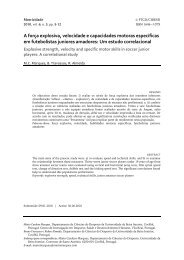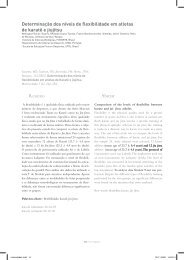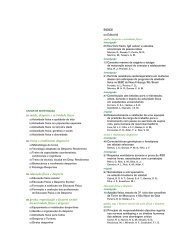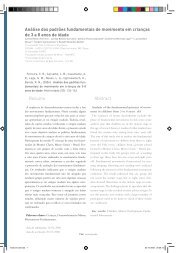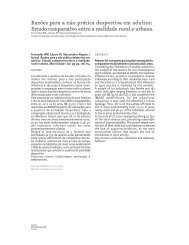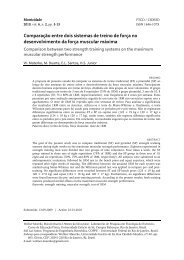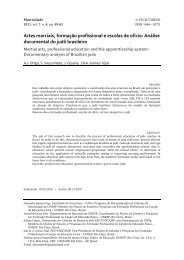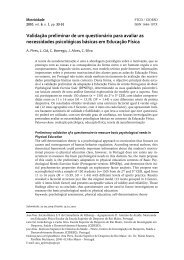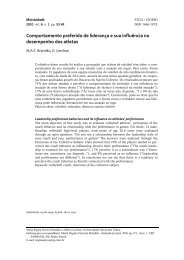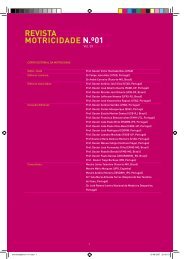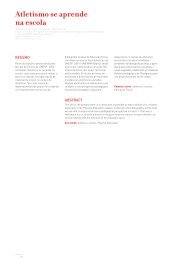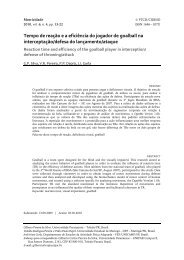revista motricidade
revista motricidade
revista motricidade
- No tags were found...
You also want an ePaper? Increase the reach of your titles
YUMPU automatically turns print PDFs into web optimized ePapers that Google loves.
Hydrodinamics of swimming | 21<br />
METHODS<br />
Participants<br />
Twenty-three young swimmers (twelve<br />
boys and eleven girls) participating on regular<br />
basis in regional and national level<br />
competitions volunteered as subjects (boys:<br />
14.42 ± 1.24 years old, 1.66 ± .09 m of height,<br />
56.45 ± 10.80 kg of body mass, 3.33 ± .78 on<br />
Tanner stages by self-evaluation; girls: 12.73 ±<br />
.79 years old, 1.60 ± .05 m of height, 47.55 ±<br />
6.27 kg of body mass, 3.00 ± .89 on Tanner<br />
stages by self-evaluation). Coaches and parents<br />
gave their consent for the swimmers<br />
participation on this study and all procedures<br />
were in accordance to the Declaration of<br />
Helsinki in respect to Human research. The<br />
Institutional Review Board of the Polytechnic<br />
Institute of Bragança approved the study<br />
design.<br />
Instruments and Procedure<br />
TTSA data collection<br />
The TTSA was measured using three<br />
methods. It was measured directly, with the<br />
subjects being photographed with a digital<br />
camera (DSC-T7, Sony, Tokyo, Japan) in the<br />
transverse plane from above (Caspersen,<br />
Berthelsen, Eik, Pâkozdi, & Kjendlie, 2010).<br />
Subjects were on land, in the upright and<br />
hydrodynamic position. This position is<br />
characterized by the arms being fully extended<br />
above the head, one hand above the other,<br />
fingers also extended close together and head<br />
in neutral position. Subjects wore a regular<br />
textile swimsuit, a cap and goggles. Besides the<br />
subjects, on the camera shooting field there<br />
was a calibration frame with .945 m length at<br />
the height of the xiphoid process (Morais et<br />
al., 2011). TTSA was measured from the<br />
subject’s digital photo with specific software<br />
(Udruler, AVPSoft, USA). Procedures<br />
included: i) scale calibration; ii) manual<br />
digitalization of the transverse trunk<br />
perimeter; and iii) output and recording of the<br />
TTSA value.<br />
Trunk transverse surface area was also was<br />
measured using estimation equations. To<br />
estimate TTSA using Equation 2, the body<br />
mass was measured in the upright position<br />
with a digital scale (SECA, 884, Hamburg,<br />
Germany) and body height was measured in<br />
the anthropometrical position from vertex to<br />
the floor with a digital stadiometer (SECA,<br />
242, Hamburg, Germany). To estimate TTSA<br />
using Equations 3 and 4, the chest perimeter<br />
and the chest sagital diameter were measured<br />
(Morais et al., 2011). The chest perimeter is<br />
defined as the perimeter of the trunk at the<br />
level of the xiphoid process, was measured<br />
with a flexible anthropometrical tape (Metric<br />
Tape, RossCraft, Canada) with the subject in<br />
the upright and hydrodynamic position. The<br />
chest sagital diameter is considered as the<br />
distance between the back and the highest<br />
point of the chest (i.e. antero-posterior) at the<br />
level of the xiphoid process and was also<br />
measured with a specific sliding caliper<br />
(Measuring Clip, RossCraft, Canada).<br />
Active drag and active drag coefficient calculation<br />
These hydrodynamic variables were<br />
computed using the velocity perturbation<br />
method with the help of an additional<br />
hydrodynamic body used to determine active<br />
drag in Front Crawl swimming (Kolmogorov &<br />
Duplishcheva, 1992; Kolmogorov, Rumyantseva,<br />
Gordon, & Cappaert, 1997). Active drag<br />
was calculated from the difference between the<br />
swimming velocities with and without towing<br />
the perturbation buoy. To ensure similar<br />
maximal power output for the two sprints, the<br />
swimmers were instructed to perform<br />
maximally at both 25 m trials. Between bouts<br />
swimmers had a passive rest of at least 30<br />
minutes. Each swimmer performed two<br />
maximal 25 m at Front Crawl with an<br />
underwater start with and without the<br />
perturbation device. Subjects performed the<br />
bouts alone without any other swimmer in the<br />
same swim lane and in the nearby lanes to<br />
reduce drafting, pacing effects and bias in the<br />
drag force. Swimming velocity was assessed<br />
during 13 m (between 11 m and 24 m from the<br />
starting wall). The time spent to cover this



